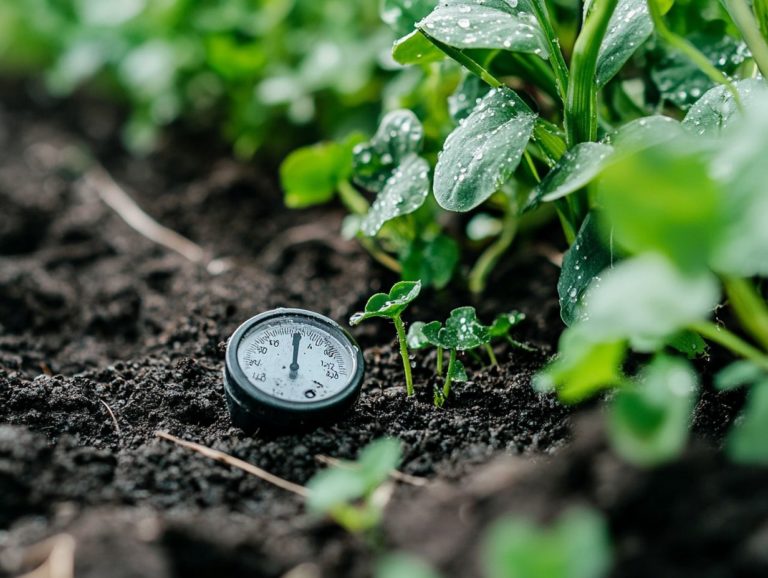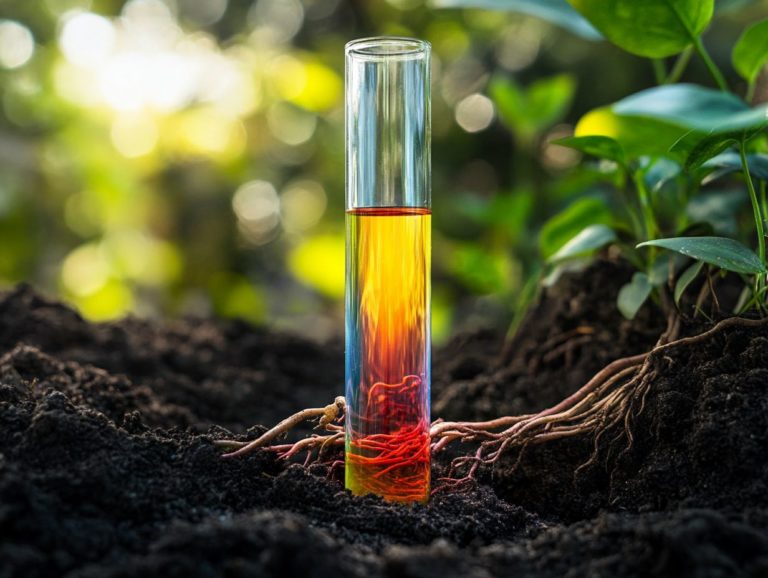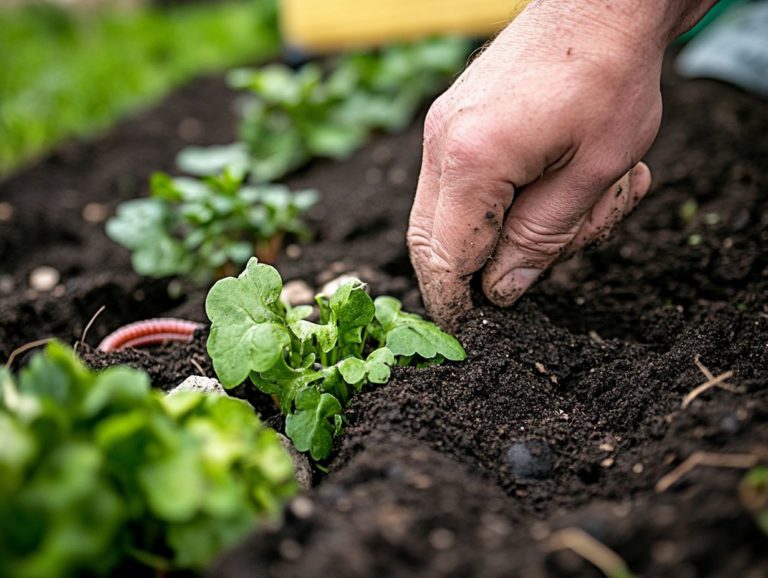Understanding Soil pH and Water Retention
Soil pH is important in gardening and agriculture, affecting everything from plant growth to the availability of nutrients.
This article explores the essential elements of soil pH, examining the factors that influence it, the best methods for precise testing, and its impact on water retention.
By adjusting pH, you can enhance soil structure and improve moisture retention. Discover effective techniques and products that will optimize the health of your garden.
Whether you re a seasoned gardener or just beginning your journey, understanding soil pH is fundamental to nurturing thriving plants and ensuring a balanced soil environment.
Contents
- Key Takeaways:
- The Importance of Soil pH
- Factors Affecting Soil pH
- Measuring Soil pH
- How pH Affects Water Retention
- Improving Water Retention with pH Adjustments
- Frequently Asked Questions
- What is soil pH and why is it important for plant growth?
- How does soil pH impact water retention?
- What is the ideal pH range for most plants to thrive?
- Can soil pH be changed and why is it important?
- How does water retention in soil affect plant growth and soil texture?
- What are some signs of poor water retention in soil and how can it be improved?
Key Takeaways:
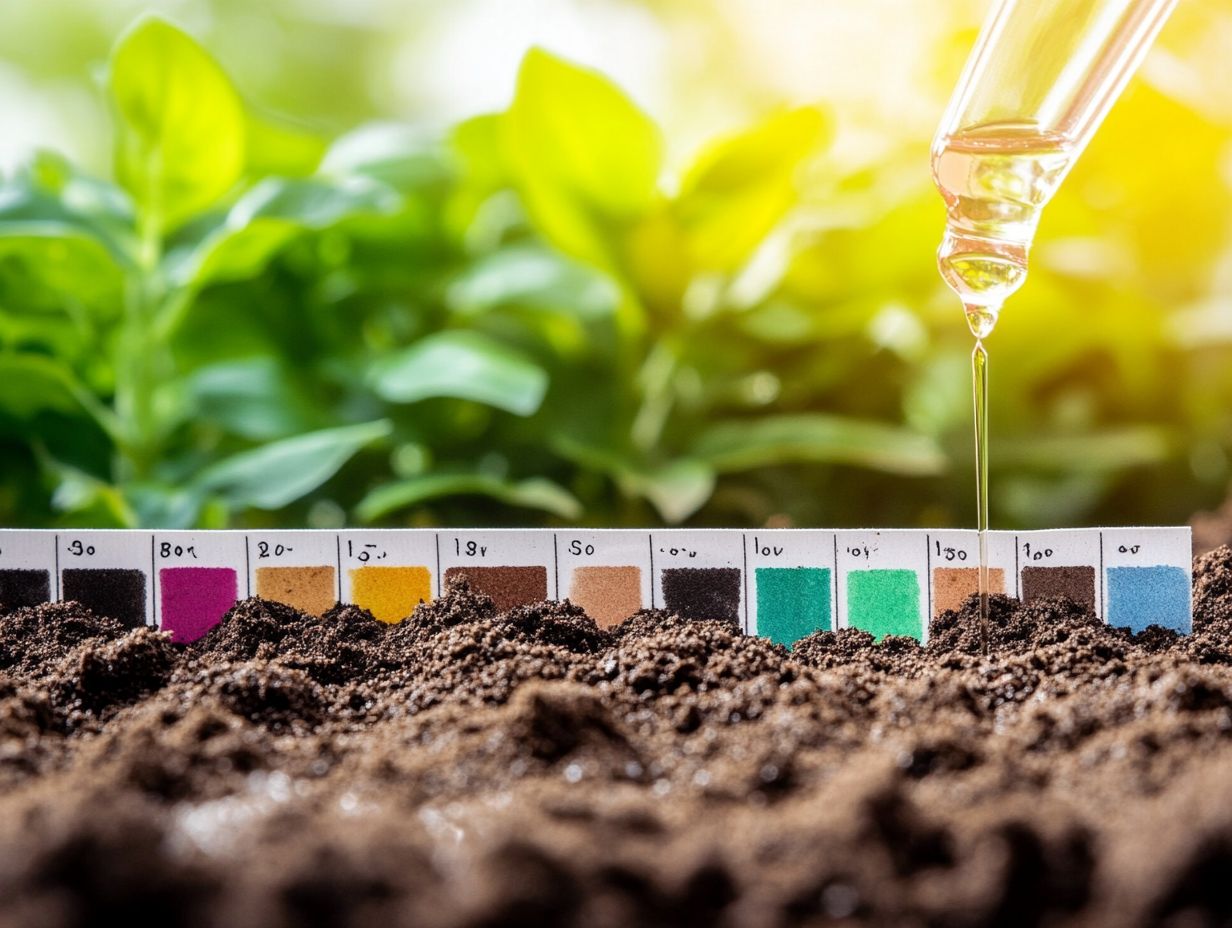
- Soil pH plays a crucial role in plant growth and nutrient availability.
- Natural and human factors can significantly impact soil pH.
- The relationship between pH and water retention can help improve soil structure and plant health through pH adjustments, ensuring optimal nutrient availability.
The Importance of Soil pH
Understanding soil pH is exciting because it directly impacts your garden’s success! It plays a significant role in plant health and growth by influencing nutrient availability, soil composition, texture, and overall fertility.
Grasping the pH scale is essential for you as a gardener. It helps cultivate an environment that fosters robust plant roots and facilitates optimal organic matter decomposition. This process enriches the soil with vital nutrients like magnesium, calcium, potassium, and phosphorus.
By conducting a soil test to evaluate acidity or alkalinity levels, you can make informed decisions about liming (adding lime to reduce soil acidity) and amendments to achieve a well-balanced soil environment.
Effects on Plant Growth and Nutrient Availability
The effects of soil pH on your plants’ growth and nutrient availability are significant. They shape how effectively plants can absorb essential nutrients from the soil.
When pH levels stray from the optimal range, critical nutrients like nitrogen, phosphorus, and potassium may become less accessible or present in excessive amounts. For example, in highly acidic soils, essential elements like calcium can become deficient while toxic elements like aluminum rise, stunting root development.
The soil’s texture and composition are crucial for moisture retention and aeration, further impacting growth. Maintaining a well-balanced pH not only enhances nutrient uptake but also nurtures healthy root systems, vital for your plants to flourish.
Factors Affecting Soil pH
Numerous factors influence soil pH, from natural processes like weathering and decomposition of organic matter to human activities such as fertilizer application and land management practices.
Natural and Human Influences
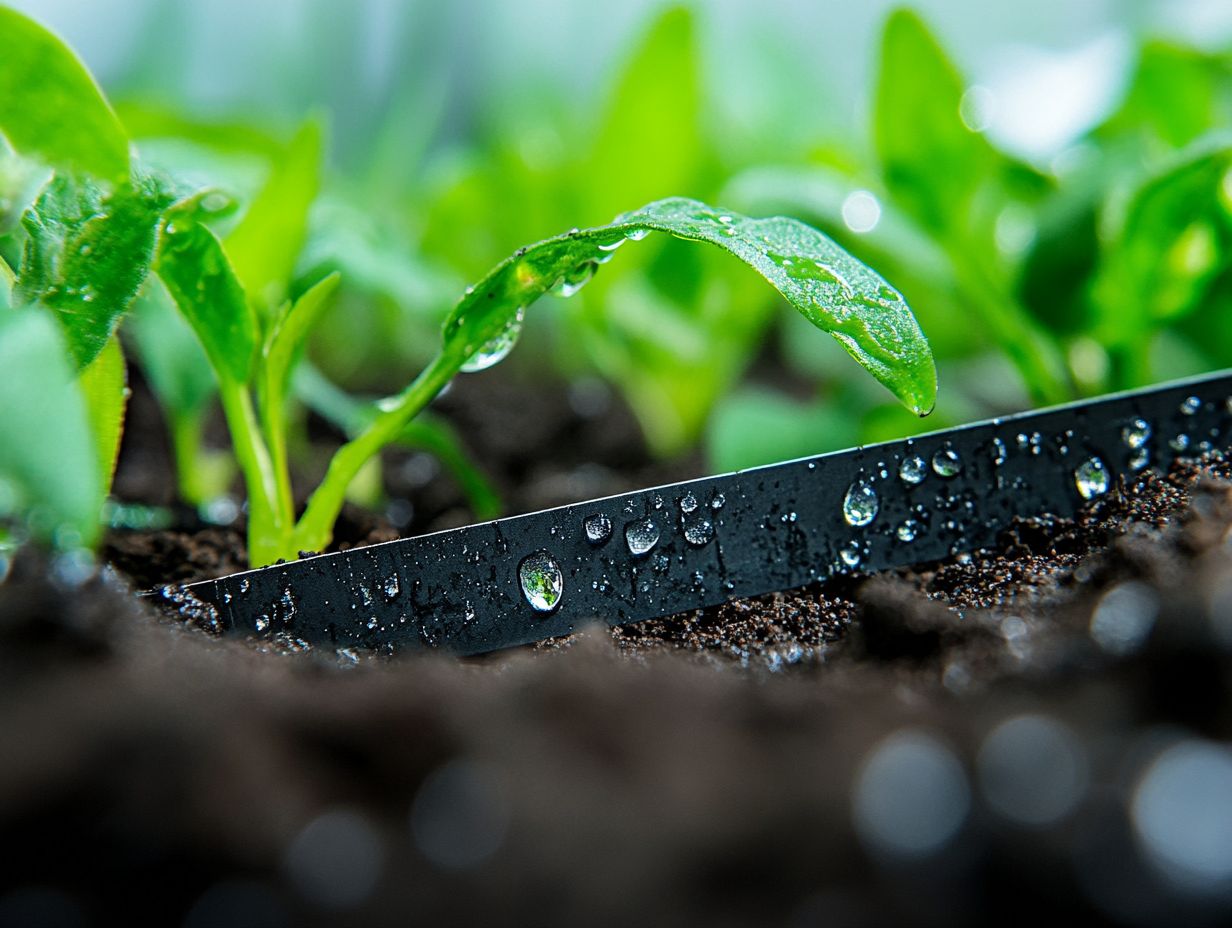
Natural factors such as climate, vegetation, and geology significantly shape soil pH. Your human actions like land use and agricultural practices can dramatically transform this essential parameter, impacting soil health.
Consider how rainfall patterns come into play; they can leach away basic cations like calcium and magnesium, leading to increased soil acidity. The buildup of organic matter from leaf litter and decomposing plants tends to enhance both soil structure and acidity over time.
Your practices, such as liming, can effectively counteract acidity. The application of fertilizers often adjusts pH levels to meet the needs of specific crops, ensuring healthy plant growth.
This delicate balance of acidity and alkalinity is crucial for agricultural productivity and local ecosystems. Certain plants thrive within specific pH ranges, influencing biodiversity and the overall health of the area. Your choices in soil management can have far-reaching implications, affecting both crops and ecosystems alike.
Start testing your soil pH today for a healthier garden!
Measuring Soil pH
Measuring soil pH is essential for you as a gardener or agricultural professional. It allows for a precise assessment of soil health and nutrient availability, guiding you in crafting effective management strategies for optimal plant growth.
Methods and Tools for Accurate Testing
There are various methods and tools for accurately testing soil pH, including pH meters, test kits, and laboratory analyses. Each offers its own blend of precision and convenience.
For instance, pH meters deliver instant readings and are ideal if you prioritize accuracy. However, don t skip following the manufacturer’s instructions it’s crucial for getting reliable results. Test kits are user-friendly and generally budget-friendly, making them perfect for the casual gardener, but may sometimes lack the sensitivity needed for precise measurements. For the best results, consider lab tests, but be prepared to send your samples away.
To make the most of these tools, collect samples evenly and check your soil pH every few years. By implementing best practices like seasonal testing and keeping meticulous records of pH levels, you’ll be well-equipped to make informed decisions that enhance soil health and support robust plant growth.
How pH Affects Water Retention
Understanding how pH affects water retention can make a huge difference in your garden! Soil pH plays a significant role in shaping soil structure, drainage, and moisture availability each vital for fostering healthy plant development.
Understanding this connection allows you to optimize conditions for your plants, ensuring they thrive in their gardening environment, ensuring appropriate nutrient availability.
Relationship between pH and Soil Structure
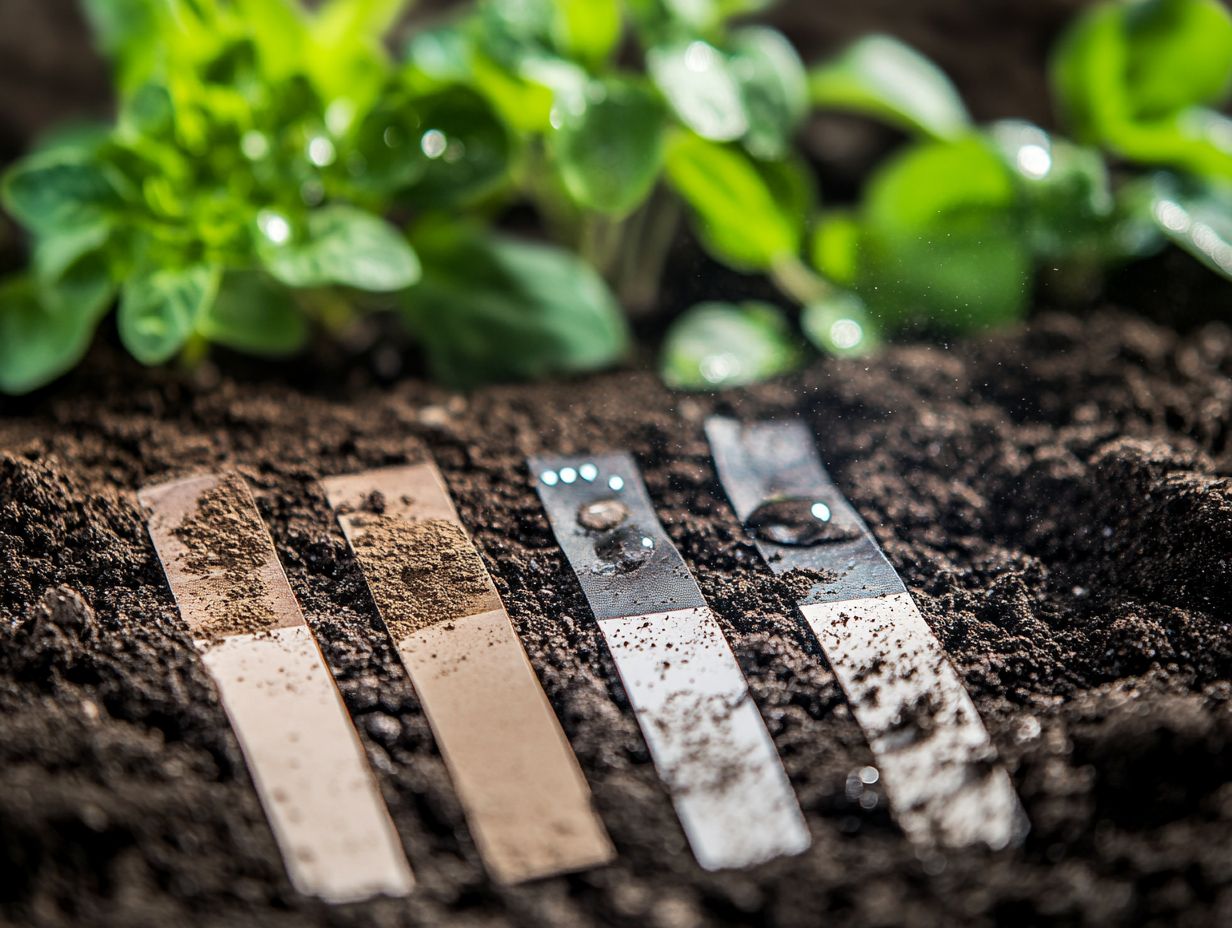
The relationship between soil pH and soil structure is crucial for your gardening success. pH directly influences how tiny particles in the soil and organic matter arrange themselves. This arrangement affects both water retention and nutrient availability.
When soil swings too far toward acidity or alkalinity, you may encounter compaction or particle aggregation, altering the pathways through which water percolates. Such changes can restrict drainage or lead to waterlogging, severely hindering plant growth.
The health of your soil ecosystem hinges significantly on microorganisms, which are essential for breaking down organic matter and enhancing soil structure. These beneficial microbes facilitate recycling nutrients, creating a balanced environment that promotes robust plant development and ensures essential nutrients are readily available for your plants to thrive.
Improving Water Retention with pH Adjustments
Improving water retention through pH adjustments offers a sophisticated strategy for enhancing soil quality, ultimately fostering sustainable plant growth and a thriving garden.
This method improves your garden’s health and supports eco-friendly practices that contribute to a flourishing environment.
Start testing your soil today and watch your garden thrive!
Effective Techniques and Products
To improve water retention through pH adjustments, you can use various effective techniques and products. These include applying organic matter, fertilizers, and specially formulated soil amendments that help create a balanced pH environment. This ensures optimal moisture retention.
By incorporating composted materials and well-rotted manure, you can enhance soil structure, making it easier for moisture to be retained, especially in drought-prone areas.
Using specific fertilizers, like slow-release granules, maintains stable nutrient levels while preventing drastic pH fluctuations. Soil amendments such as vermiculite and perlite are natural minerals that help retain moisture and boost aeration, enhancing your garden’s resilience.
Make testing your soil pH a regular habit! This ensures your garden gets the care it deserves. The combined practices work together to create a thriving garden ecosystem that retains moisture and boosts soil health.
Frequently Asked Questions
What is soil pH and why is it important for plant growth?
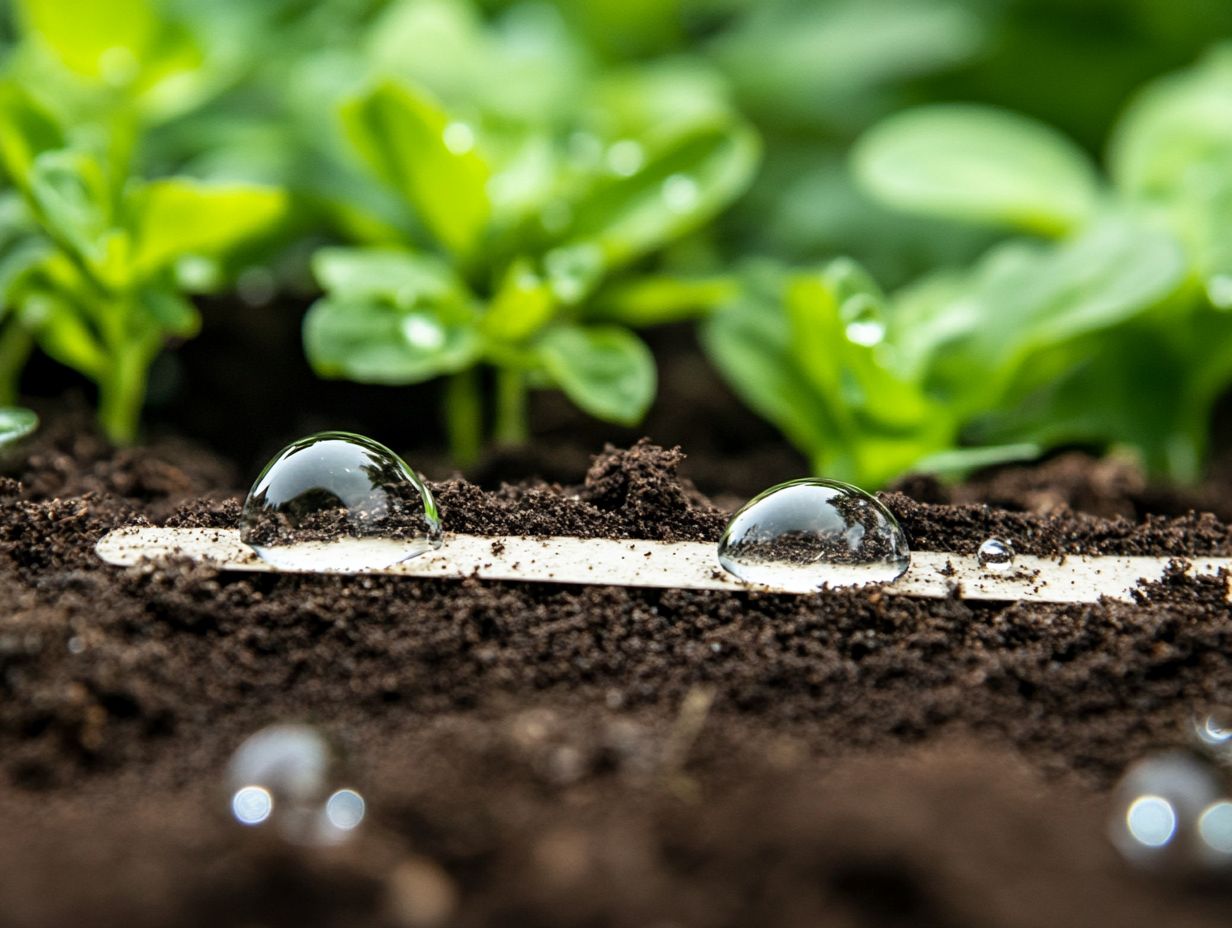
Soil pH is a measure of the acidity or basicity of the soil. It affects how nutrients are available in the soil and the activity of microorganisms that help plants absorb these nutrients.
How does soil pH impact water retention?
The pH level of soil can significantly affect its water retention capabilities. Soil with a high pH (basic) has larger particles, creating larger pore spaces that allow water to drain easily. In contrast, low pH (acidic) soil has smaller particles, resulting in smaller pore spaces that hold onto water more tightly. Understanding why soil aeration is crucial for water retention can further enhance these properties.
What is the ideal pH range for most plants to thrive?
Most plants prefer slightly acidic soil, with a pH range of 6.0 to 6.5. However, some plants may have specific pH requirements, so it’s important to research the needs of the plants you are growing.
Can soil pH be changed and why is it important?
Yes, soil pH can be altered by adding amendments like lime to raise the pH or sulfur to lower it. These changes can take time and should be done carefully, with regular testing, to avoid extreme pH levels that can harm plants.
How does water retention in soil affect plant growth and soil texture?
Water retention in soil is crucial for plant growth. It keeps the soil moist, providing a steady supply of water and nutrients to the roots. It also prevents water from draining too quickly, which can lead to drought stress for the plants.
What are some signs of poor water retention in soil and how can it be improved?
Poor water retention can be indicated by wilting plants, dry and crumbly soil, and a lack of plant growth. Conversely, overly wet soil can also harm plants, causing root rot and other issues. Maintaining a good balance of water retention is vital for optimal plant growth.
Ready to boost your garden’s health? Consider testing your soil pH and exploring specific amendments for your soil!

